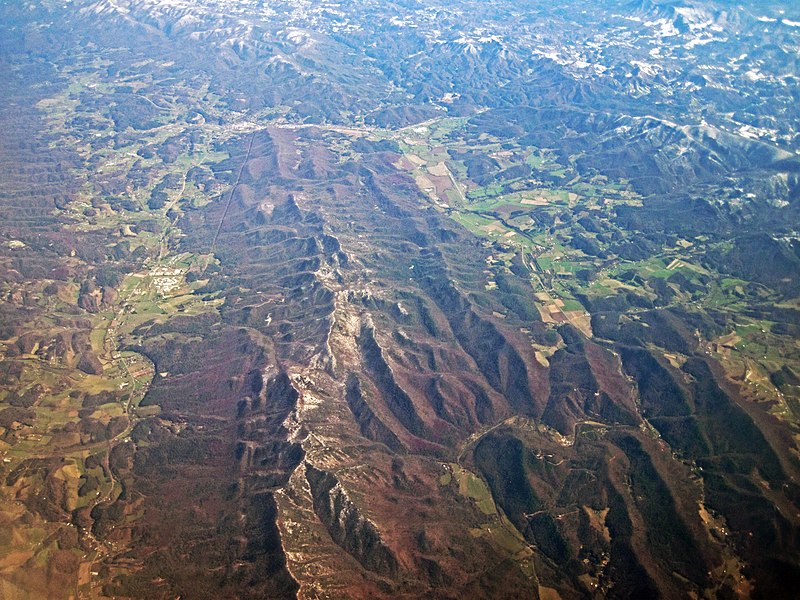File:Doe Mountain Anticlinorium (northeastern tip of Tennessee, USA) 3.jpg

Original file (4,000 × 3,000 pixels, file size: 9.71 MB, MIME type: image/jpeg)
Captions
Captions
Summary[edit]
| DescriptionDoe Mountain Anticlinorium (northeastern tip of Tennessee, USA) 3.jpg |
English: (looking ~east-northeast)
This is an oblique aerial view of the Appalachians in eastern America. The Appalachian Mountains consist of three physiographic provinces. From west to east, they are: 1) the Valley & Ridge; 2) the Blue Ridge; and 3) the Piedmont. The Appalachians extend from Quebec to Alabama, go underground in the Mississippi River area, and re-emerge in the Arkansas-Oklahoma-Texas area as the Ouachita Mountains. The overall mountain chain formed as a result of three separate tectonic collision events during the Paleozoic. The earliest was the Taconic Orogeny (Late Ordovician to Early Silurian) - a volcanic island arc collided with what is now the New England area. Next was the Acadian Orogeny (Late Silurian to Devonian) - a microcontinent called Avalonia collided with eastern North America. The third and most significant mountain building event was the Allegheny Orogeny (Pennsylvanian) - Africa collided with eastern North America. This was a Pangaea supercontinent formation event. The Appalachians mostly lack the sharp-peaked mountains common to western America's Cordillera, the Andes of South America, the Alps of Europe, or the Himalayas of Asia. Compared with those geologically young mountain chains, the Appalachians are relatively old - they have been subjected to long-term erosion for about one-third of a billion years. The forest-covered ridges seen here - the Doe Ridges - are in Johnson County, in the northeastern tip of Tennessee. They are part of the Blue Ridge province (the Great Valley is a little to the northwest of here). The Blue Ridge is mostly composed of Precambrian-aged basement rocks (igneous & metamorphics). But here, the Doe Ridges consist of structurally folded Cambrian sedimentary rocks in the form of an imbricated antiform - the Doe Mountain Anticlinorium. The stratigraphic units in the Doe Mountain Anticlinorium include the Rome Formation, Shady Dolomite, Erwin Formation, Hampton Formation, and Unicoi Formation (see King & Ferguson, 1960). See info. at: en.wikipedia.org/wiki/Appalachian_Mountains Reference cited: King & Ferguson (1960) - Geology of northeasternmost Tennessee. United States Geological Survey Professional Paper 311. 136 pp. 19 pls. (pubs.usgs.gov/pp/0311/report.pdf and pubs.usgs.gov/pp/0311/plate-01.pdf) |
| Date | |
| Source | https://www.flickr.com/photos/47445767@N05/45222264712/ |
| Author | James St. John |
Licensing[edit]
- You are free:
- to share – to copy, distribute and transmit the work
- to remix – to adapt the work
- Under the following conditions:
- attribution – You must give appropriate credit, provide a link to the license, and indicate if changes were made. You may do so in any reasonable manner, but not in any way that suggests the licensor endorses you or your use.
| This image was originally posted to Flickr by James St. John at https://flickr.com/photos/47445767@N05/45222264712. It was reviewed on 22 October 2020 by FlickreviewR 2 and was confirmed to be licensed under the terms of the cc-by-2.0. |
22 October 2020
File history
Click on a date/time to view the file as it appeared at that time.
| Date/Time | Thumbnail | Dimensions | User | Comment | |
|---|---|---|---|---|---|
| current | 22:46, 22 October 2020 |  | 4,000 × 3,000 (9.71 MB) | Ser Amantio di Nicolao (talk | contribs) | Uploaded a work by James St. John from https://www.flickr.com/photos/47445767@N05/45222264712/ with UploadWizard |
You cannot overwrite this file.
File usage on Commons
There are no pages that use this file.
Metadata
This file contains additional information such as Exif metadata which may have been added by the digital camera, scanner, or software program used to create or digitize it. If the file has been modified from its original state, some details such as the timestamp may not fully reflect those of the original file. The timestamp is only as accurate as the clock in the camera, and it may be completely wrong.
| Camera manufacturer | Canon |
|---|---|
| Camera model | Canon PowerShot D10 |
| Exposure time | 1/125 sec (0.008) |
| F-number | f/8 |
| ISO speed rating | 80 |
| Date and time of data generation | 12:01, 3 November 2012 |
| Lens focal length | 6.2 mm |
| Image title | |
| Width | 4,000 px |
| Height | 3,000 px |
| Bits per component |
|
| Pixel composition | RGB |
| Orientation | Normal |
| Number of components | 3 |
| Horizontal resolution | 180 dpi |
| Vertical resolution | 180 dpi |
| Software used | Adobe Photoshop Elements 13.0 (Macintosh) |
| File change date and time | 12:21, 12 October 2018 |
| Y and C positioning | Co-sited |
| Exif version | 2.21 |
| Date and time of digitizing | 12:01, 3 November 2012 |
| Meaning of each component |
|
| Image compression mode | 3 |
| APEX shutter speed | 6.96875 |
| APEX aperture | 6 |
| APEX exposure bias | 0 |
| Maximum land aperture | 2.96875 APEX (f/2.8) |
| Metering mode | Pattern |
| Flash | Flash did not fire, compulsory flash suppression |
| Supported Flashpix version | 1 |
| Color space | sRGB |
| Focal plane X resolution | 16,460.905349794 |
| Focal plane Y resolution | 16,483.516483516 |
| Focal plane resolution unit | inches |
| Sensing method | One-chip color area sensor |
| File source | Digital still camera |
| Custom image processing | Normal process |
| Exposure mode | Auto exposure |
| White balance | Auto white balance |
| Digital zoom ratio | 1 |
| Scene capture type | Landscape |
| Lens used | 6.2-18.6 mm |
| Date metadata was last modified | 08:21, 12 October 2018 |
| Unique ID of original document | 1860EF83CBBE8F3E8BC51C6C1AAC0776 |
| IIM version | 29,736 |